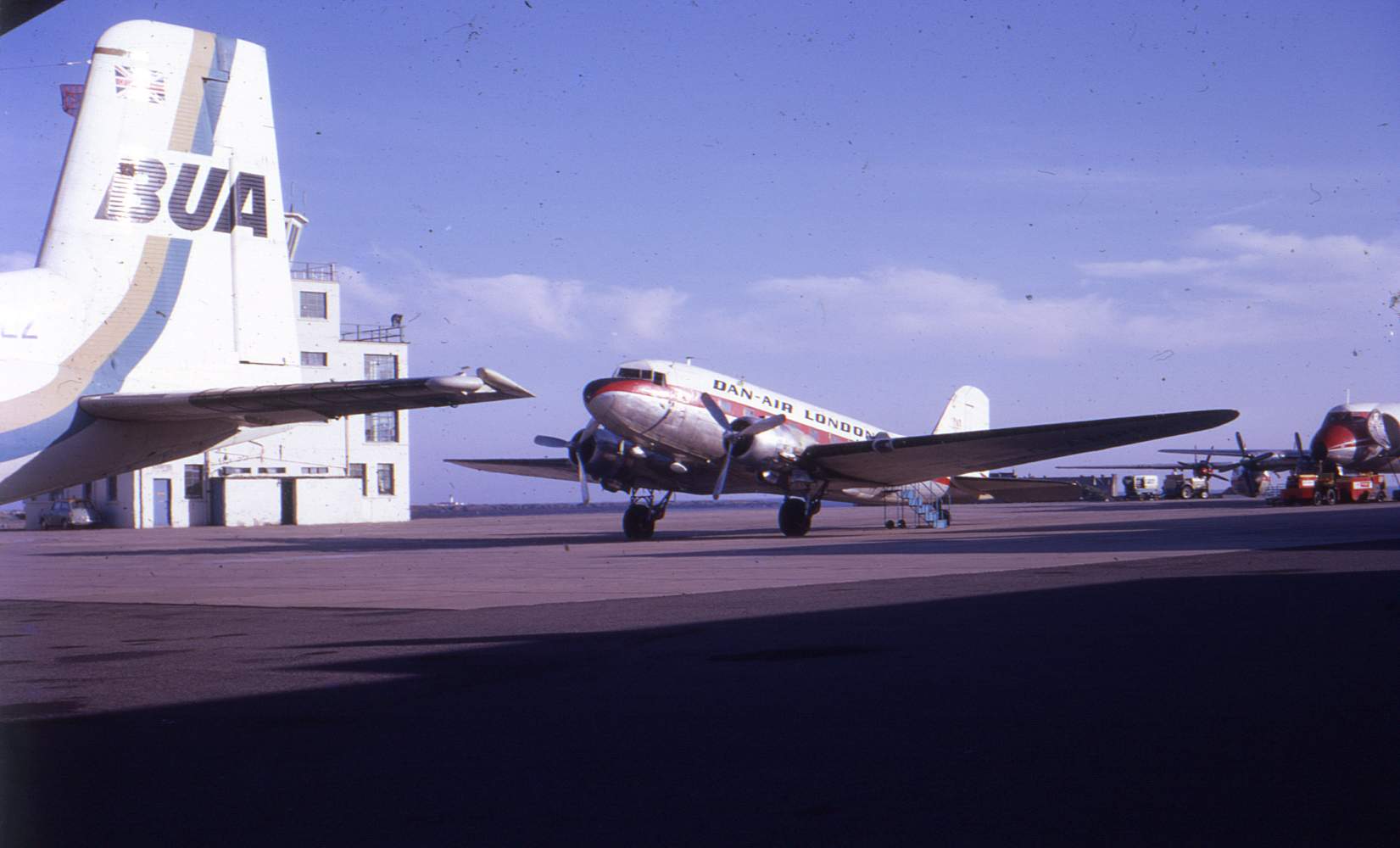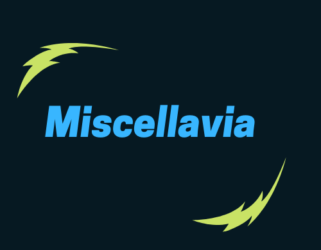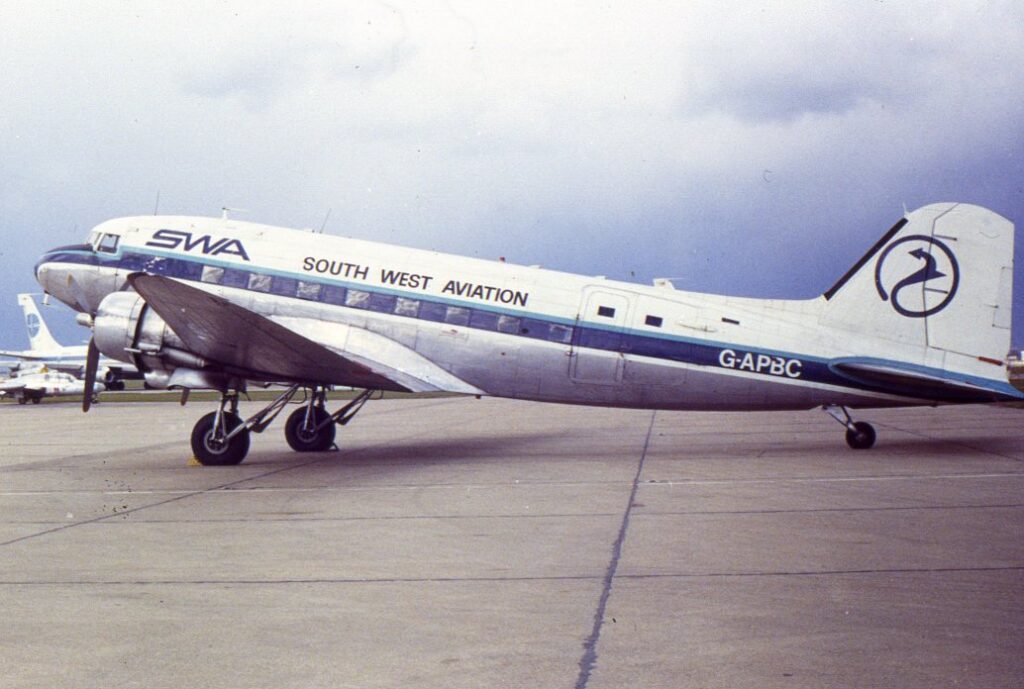
Construction Number 15676/ 27121 was built for the USAAF under contract AC-40652 at Douglas’s Oklahoma City plant. A C-47B, she was allocated the serial 43-49860 and delivered on 10th January 1945 (1). The Dakota IV was supplied to the RAF under the Lend/ Lease scheme and given the serial KN250.
KN250’s RAF career started with 300 Wing which had been formed at Mascott Airport, Sydney, Australia in November 1944 with the purpose of supporting the Royal Navy Pacific Fleet. As such, 300 Wing had the distinction of being the only WW2 RAF unit to be commanded by a Royal Navy officer. 243 Squadron RAF, originally a Spitfire unit, was allocated thirty Dakotas and these were delivered from the States in two echelons of fifteen aircraft in January and February 1945. KN250 is believed to have traveled in the second tranche as she arrived at Mascott Airport on March 3rd 1945. With the call sign VMYAQ, KN250 will have carried-out general transport duties. A further RAF unit, 238 Squadron, arrived in Australia from Burma in June 1945 and was based at Parafield, Adelaide. The complement of the two squadrons rose to seventy Dakotas.
Following the end of WW2, 300 Group and 243 Squadron were disbanded on April 15th 1946 and some of their aircraft were transferred to Hong Kong and Singapore operations. KN250, however, traveled north to Great Britain, arriving on 11th April 1946. Nominally, the Dakota joined 525 Squadron RAF which had, since March 1946, assumed the role of newspaper and mail deliverer to British units on the Continent from a base at Abingdon. On December 1st 1946, elements of 52 Squadron plus 525 Squadron were rationalised to form a rejuvenated 238 Squadron (2). Subsequently, Dakotas of 238 took part in the Berlin Airlift of 1948 but, by then, KN250 had moved on to #1 Parachute Training School on November 5th 1947. The unit was based at Upper Heyford, although Honington is also mentioned (1), but moved to Abingdon in June 1950. The Parachute and Glider Training School was also based at Abingdon although it operated mostly from Netheravon airfield between early 1948 and early Summer 1950.
During take-off from Netheravon on a glider-towing exercise on 20th April 1950, KN250 suffered a starboard engine fire. The pilot of the towed glider, P1 Welveart, released the Horsa which went on to land safely. The Dakota, however, crash landed around 4 miles North North East of the airfield and was seriously damaged. Replaced on unit strength by KN641, the stricken KN250 was trucked back to Netheravon where she was assigned to the Army Air Corps on June 7th 1950 for use as an instructional airframe. With an ID of 6763M, the Dakota remained as a training aid until demobilised in 1957. Sold to civilian operator Transair, she was dismantled and driven to their Croydon base where she was rebuilt and, on 25th April 1957, registered G-APBC.
(1) Air Britain’s DC-1/ DC-2/ DC-3: the First Seventy Years by Jennifer Gradidge.
(2) RAF documentation for 525 Squadron May 1946 to July 1946 show no record of KN250. Similarly, records for 238 Squadron for that time (although very hard to read) don’t seem to include KN250 between August and October 1947.
Transair was an inventive company which had been formed in 1947 and grown by flying Airspeed Consuls and Avro Anson 1s on newspaper, mail and holiday flights. Well-maintained and effectively upgraded, the Ansons carried freight loads typical of the era: lobsters, pharmaceuticals, textiles and foreign and domestic newspapers (3). Around twenty Ansons passed through the fleet between the late forties and 1952 but the airline had ambitions to carry larger loads and began adding Dakotas from 1953 onwards. The earlier qualities of the Company were transferred to the well-maintained Dakota fleet and many of the shining lights of British airline history served with Transair: G-AMYJ, G-AMPZ, G-AMRA, G-AMSV, G-ANTC and G-AOUD. As with the Anson fleet, Transair implemented innovative upgrades to the Dakotas which were eventually marketed as a ‘Dakmaster’ upgrade. Their aim was to make the ex-military aircraft faster, more economic and safer. To this end they fitted up-rated engines, wheel-well doors, modified hydraulics (to give quicker undercarriage retraction times), modified propellers and Goodyear disc brakes. By 1956, their Croydon workshops had modified five of the Transair fleet and supplied an amazing 115 kits to other operators (4). Well-known non-Transair British Dakotas like Westpoint’s G-ALYF, Derby Aviation’s G-ANTD and Scottish Aviation/ Dan Air’s G-AMPP benefited from Dakmaster upgrades.
G-APBC was the final C-47 acquired by Transair as, by summer 1957, the airline had been acquired by Airwork and had its eyes set firmly on turboprop equipment. The first two Viscount 804s arrived while G-APBC was being converted to civilian specification and the Dakota never entered Transair service. Instead, she was sold to Derby Airways at their Burnaston, Derby, base to bolster their expanding Dakota fleet. G-APBC had many of the Dakmaster upgrades including the undercarriage doors – these were retained throughout her British Midland and South West Aviation days but appear to have been removed at her first overhaul by Skyways in late 1972.
(3) British Independent Airlines 1946-76, Tony Merton-Jones, TAHS, 2000.
(4) Dakmaster information from www.british-caledonian.com
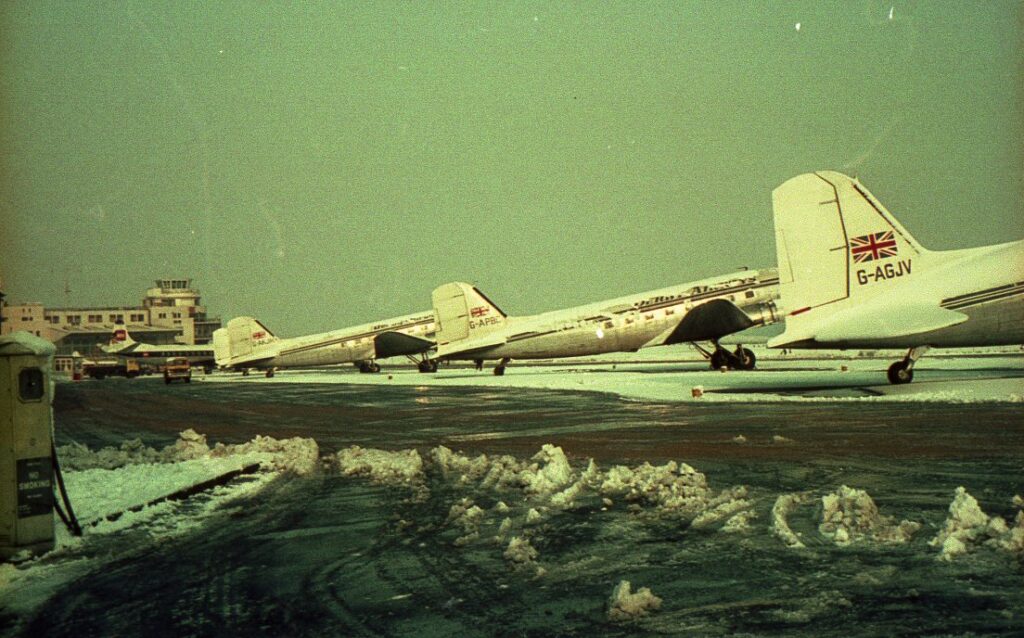
Derby Aviation was another company with early origins, in their case the 1938 establishment of Air Schools Ltd at Burnaston, Derby. Developing via WW2 pilot training at Derby and Wolverhampton, te group had expanded post-war into passenger and freight charter operations. By 1949, associated maintenance and repair facilities had been added. Holiday flights with DH Dragon Rapides to the Isle of Man and the Channel Islands evolved with the Spring 1955 acquisition of 271 Squadron veteran Dakota G-ANTD from the CE Harper Aircraft Company. A second C-47, G-AOGZ, once the personal aircraft of Field Marshall Viscount Montgomery, was added in June 1956 (3) in time for the two Dakotas to take part in the airlift of refugees from Austria to the UK during the abortive Hungarian Revolution.
G-APBC became Derby Aviation’s third C-47 on May 1st 1958 and arrived at Burnaston eight days later. Quickly pressed into action, she made her first revenue-earning flight on May 10th, flew the first service from Northampton’s Sywell airport to Jersey on May 20th and also inaugurated an Oxford to Jersey 3 days later on 23rd. An issue with the Channel Islands flights which seems odd today was that the services had to include intermediate stops at Southampton to effect Customs clearance. A Channel Islands service from Luton had also been added and, by September, the Dakotas were flying ‘proper’ international services from Birmingham to Ostend four times per week. The Dakotas also operated inclusive tour charters to destinations such as Austria, France, Spain and Switzerland. Scheduled services were flown between Derby and Glasgow and the Isle of Man, mostly by Dakotas, while Derby Aviation’s three Miles Marathons took over the services from Sywell and Oxford. Longer distance charter work for G-APBC included a flight to Libya via Malta on 19th October 1958.
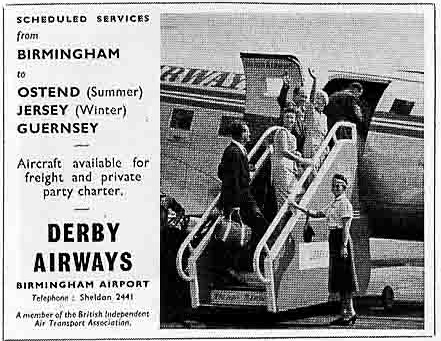
The airline changed its name from Derby Aviation to Derby Airways for the 1959 season and added two ex-Cambrian C-47s, G-AMSW and G-AMSX. The fleet of five Dakotas was equipped with Decca Navigator Mk8 with a moving map display as the sphere of operations expanded to include additional schedules from Cambridge and Gloucester. IT flights were operated with the Dakotas from Derby and also Birmingham, Gatwick and Manchester to the regular summer destinations and also to winter ski resorts in Norway, Austria and Switzerland. G-APBC was back in Malta on February 10th and 11th 1960 for fuel stops probably en route to/ from Libya again. Dakotas G-AOFZ, G-AGJV and G-AKJH were added in succession through 1960 and 1961 as the Miles Marathons were withdrawn from service. The airline often operated in conjunction with fellow Midlands DC-3 outfits Executive Air Transport and Mercury Airlines (5) as well as the Gatwick-based Overseas Air Transport. Overseas went out of business in late 1961 and Derby took over three of their Canadair Argonauts. The larger aircraft slotted into the European IT operations while the Dakotas continued scheduled flights and charters to some of the smaller airfields. On June 18th 1963, ‘BC had the honour of being the first Dakota to land at Blackbushe after the airfield’s reopening after a three year closure. However, the winter fall-off in IT work demanded that some of the Dakotas operated in mixed passenger/ freight mode. Freight schedules were developed between Derby and Belfast and, by Spring 1964, between Amsterdam and Derby, Birmingham and Bristol/ Cardiff. Further changes were afoot and, in late 1964, the Company changed its name to British Midland in the expectation of increasing its sphere of influence. The operating base moved from Burnaston to East Midlands Airport at Castle Donington the following year and the first turboprop equipment was introduced in the form of HP Dart Heralds.
(5) British Midland Airways’ long-time Managing Director, Michael Bishop, was originally ground-handling manager with Lord Calthorpe’s Mercury Airlines but joined Derby Airways and was then promoted to general manager following the acquisition of British Midland by Minster Assets in 1968.
The original Derby Aviation and Derby Airways colour scheme followed the BEA-style with a blue three-stripe cheat line running just above the windows, white above, natural metal below. The registration and the Union flag were painted on the tail fin, the aircraft’s individual name and a winged ‘DA’ symbol on the nose. The Dakotas, and a couple of Marathons, were named after Peak District Dales with G-ANTD claiming ‘Dove Dale and G-APBC ‘Derwent Dale’ . G-AMSX was named ‘Peak Dale’, the ill-starred G-AMSW ‘Fern Dale’ and G-AOGZ changed names from ‘Darley Dale’ to ‘Denby Dale’. G-AGJV and G-AKJH took names previously used on Miles Marathons; ‘Millers Dale’ and ‘Monsal Dale’ respectively (3).
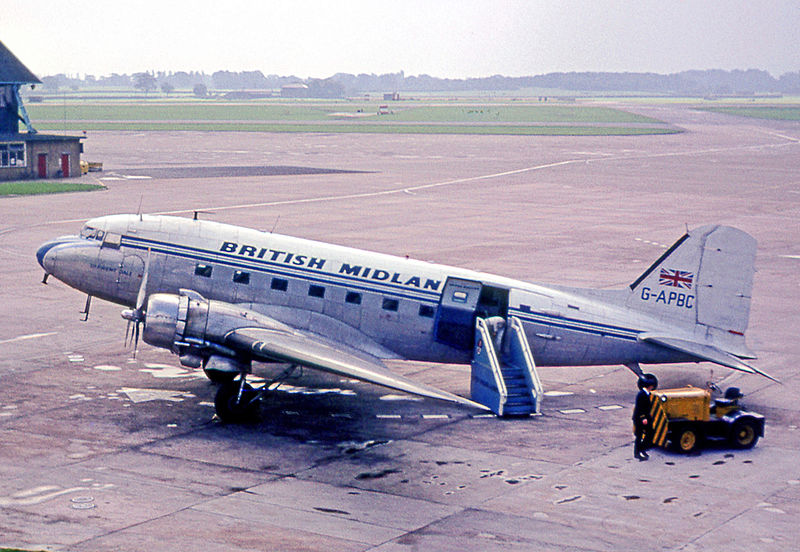
Just before transforming from Derby Airways to British Midland, the airline colour scheme changed with the ex-Overseas Argonauts adopting splendid white/ dark blue/ cyan colours with a stylised ‘DA’ on the fin and the two shades of blue continued along the aft edge of the tail assembly. Some of the Dakotas were painted in this scheme, probably only after the switch to the British Midland name. As BMA started to sell-off the first of the Dakotas, they left in the original three-blue-cheatline colours: G-AKJH went to Gregory Air Services in Spring 1965, ‘MSX left for South America in early 1966 followed by G-AOFZ destined for a short life with Gulf Aviation. G-AOGZ was sold to Strathallan Air Services in April 1967, also painted in the old scheme. G-ANTD, G-APBC and G-AGJV were favoured with the new scheme – by now the design had evolved so that the blue and cyan stripes on the tail represented two Dale peaks, the ‘DA’ had, of course, become ‘BM’ and the airline name was painted in pale blue. The dark blue cheat line was outlined in cyan above, white below, with the registration in white on the stripe and the new BMA symbol just ahead of the forward window.
By the summer of 1967, BMA was operating most of its scheduled routes with Viscounts purchased from Pakistan and BOAC although the remaining three Dakotas flew passenger schedules to Sandown from East Midlands, Birmingham and Manchester.
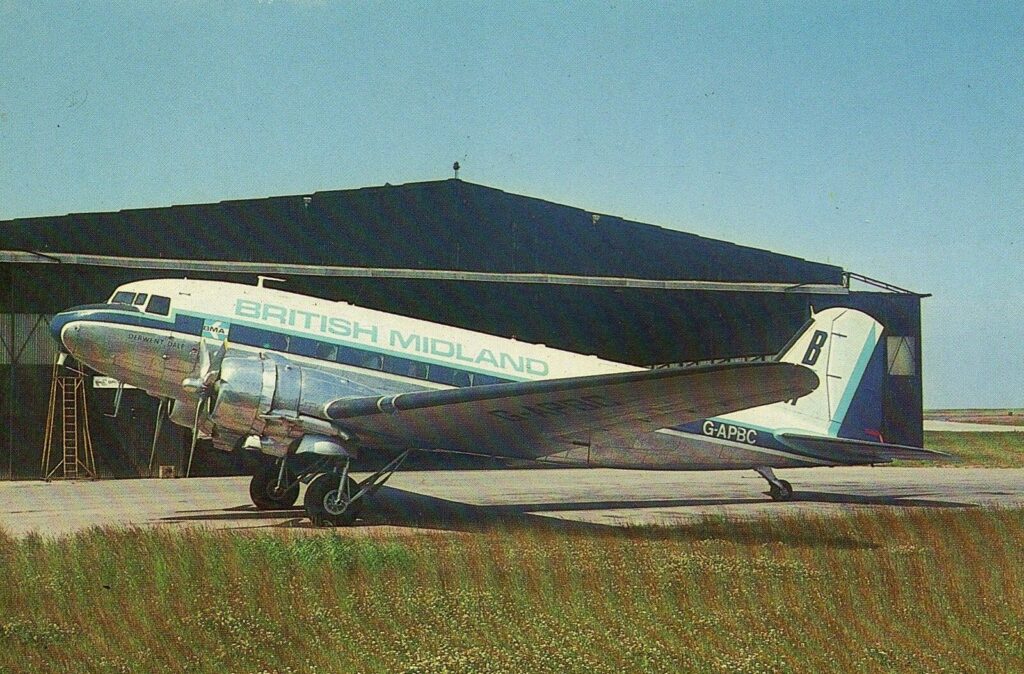
G-APBC was the next Dakota to leave BMA service, passing to South-West Aviation of Exeter in Spring 1968. She was noted at Castle Donington on April 27th wearing SWA colours – essentially much the same as the fine British Midland scheme, although the peaks on the tail were replaced by SWA’s ‘barbed arrow’. ‘BC was registered to South West Aviation at Exeter Airport on May 1st 1968 in a well-publicised move to supplement the Devon airline’s fleet. South West had been incorporated on August 1st 1966 with some ex-British Westpoint staff and had plans to take over the activities of that well-regarded airline following its liquidation earlier that year. Initially, SWA had flown as a third-level operator with one Aztec and one Travelair but Short Brothers Sales Team had convinced them to try-out the newly-launched Skyvan. In February 1968, they leased G-ATPF from Short Brothers for freight operations and the synergy with G-APBC looked set to work well.
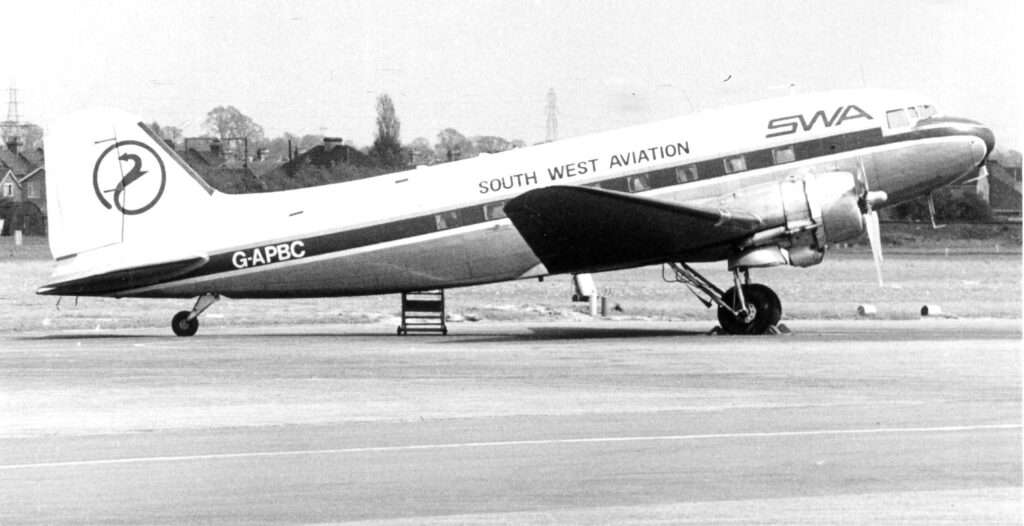
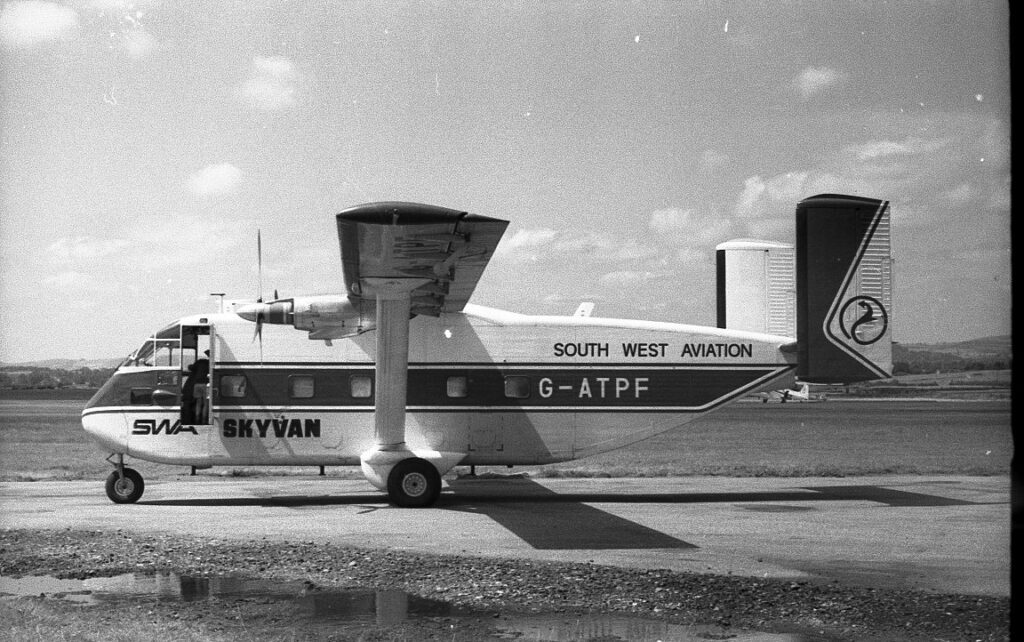
G-APBC was soon being logged at airports all over the British Isles, flying Exeter to Stansted on May 14th 1968 before a passenger charter to Leeds the following day. An appearance at the Hucknall Air Display facilitated pleasure flying before a return to ‘serious’ work at Luton on 29th June and Shannon on July 16th. Morton Air Services chartered both G-APBC and the Skyvan G-ATPF as from July 27th 1968 to assist them with their newspaper delivery contracts. On 27th, G-APBC delivered a load of newspapers to jersey before positioning to Exeter to operate British United’s return service Exeter to Belfast. Similar flight sequences continued for the two British United group companies until August 19th. G-APBC’s versatile combi configuration permitted the carriage of 36 passengers or 3.5 tons of freight – although installing and removing seats must have been tedious! BUA schedules from Exeter to both Dublin and Belfast were frequently operated by the SWA Dakota. After a short break, ‘BC was back at Gatwick on September 1st for the newspaper runs to Antwerp and Hanover. Channel Island flights were also operated and, on September 14th, a technical fault on the newspaper flight to Jersey led to an unscheduled return to Gatwick. Following three days of repairs at Gatwick, ‘BC was back in action from the airport on September 19th and continued until the end of the month. After a further three days standby, G-APBC returned to Exeter on October 3rd (6).
(6) Details from Propliner edition 111, ‘South West Aviation – Devon’s own airline’ by Tony Merton-Jones,
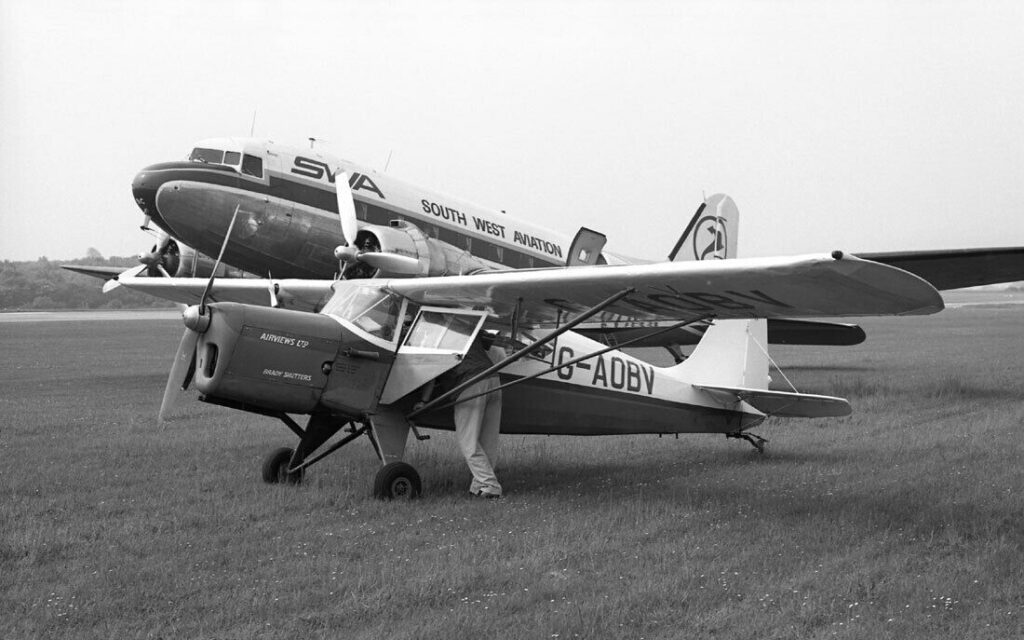
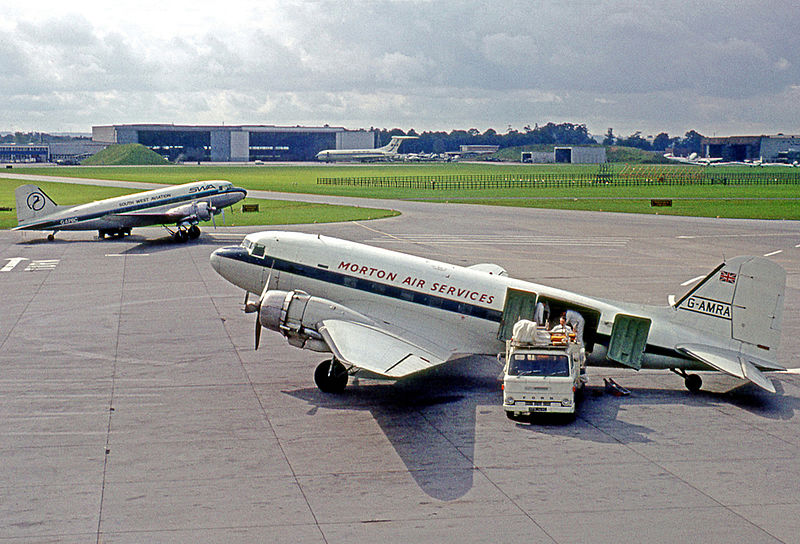
July 1st 1968 had seen the delivery of SWA’s first purchased Skyvan, G-AWCS, and this was due to be used on shorter routes to shorter strips while the Dakota concentrated on the more mainline services. G-ATPF, still in its green ex-Emerald Airways scheme, was originally due to be returned to Short’s off-hire when G-AWCS arrived. However, with the Dakota occupied on Morton’s operations, it remained in service for some months more. The C-47B was also used on charters typical of the sixties: shellfish deliveries from Edinburgh to Quimper, car parts shipments between Cologne and Cardiff in December 1968 and a Malmo to Southend flight on December 6th. In late ’68, South West Aviation applied for the licences linking Exeter with Bristol/ Cardiff, Swansea, Newquay and the Scillies which had been relinquished by Westpoint. Skyvans were specified as the modern-day equivalent of the DH Rapides which had flown Westpoints services to the Scillies, but the Dakota was the preferred option for the longer Welsh routes. SWA also acquired an interest in West Country Aircraft Servicing at Exeter, a move which afforded in-house maintenance and hangar facilities. Hangar space was also negotiated at Swansea.
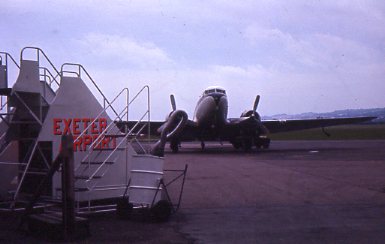
With so much work available, South West Aviation decided to add a second C-47 early in the New Year. G-AMYJ, also an ex-Transair Dakmaster, was purchased from the British United group and delivered on May 10th 1969. As well as existing work, the airline planned to exploit the increasing amount of North Sea oil industry related charter work. G-APBC headed for Norwich at the end of April to commence a Norwich to Teesside to Aberdeen oilfield contract carrying both freight and passengers. With the occasional onward sector to Sumburgh in the Shetland Islands, ‘BC flew the route for an initial 14 days. A Skyvan also joined-in the service as required and a DH Dove was chartered briefly in advance of the arrival of G-AMYJ. The second Dakota made it to Norwich on May 13th to take over from ‘BC until July 1969 while the original C-47 returned to Exeter for maintenance. Work was carried-out on ‘PBC at both Exeter and Weston-Super-Mare. G-APBC also continued with the occasional stand-in flights for British United between Exeter and Irish destinations as well as transporting Ford car parts between Cologne and Cardiff.
Further stand-in work continued into 1970 with the SWA Dakotas contracted to fly Dan Air’s Bristol/ Cardiff to the Isle of Man weekend service as from May 23rd. The Exeter-based Dakotas supplemented Dan Air’s G-AMPP on this route for the last few months before ‘PP was replaced by a Nord 262. G-APBC also substituted for one of Dan Air’s Ambassadors on the Isle of Man to Prestwick route on August 15th 1970 when there was a low complement of passengers. South West Aviation Dakotas also flew day return routes between Cherbourg and both Exeter and Southampton with sponsorship from the French city’s Chamber of Commerce. The photos taken below were taken on a summer evening in 1970 when both SWA Dakotas had just returned to Exeter from Cherbourg. The Devon airfield had been swamped with banks of fog and the sound of Pratt & Whitney Twin Wasps had announced the imminent arrival of the two Dakotas before they emerged from the murk and taxied-in to the terminal.
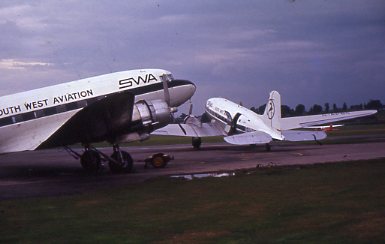
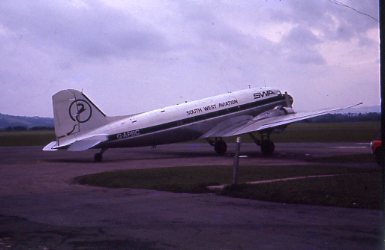
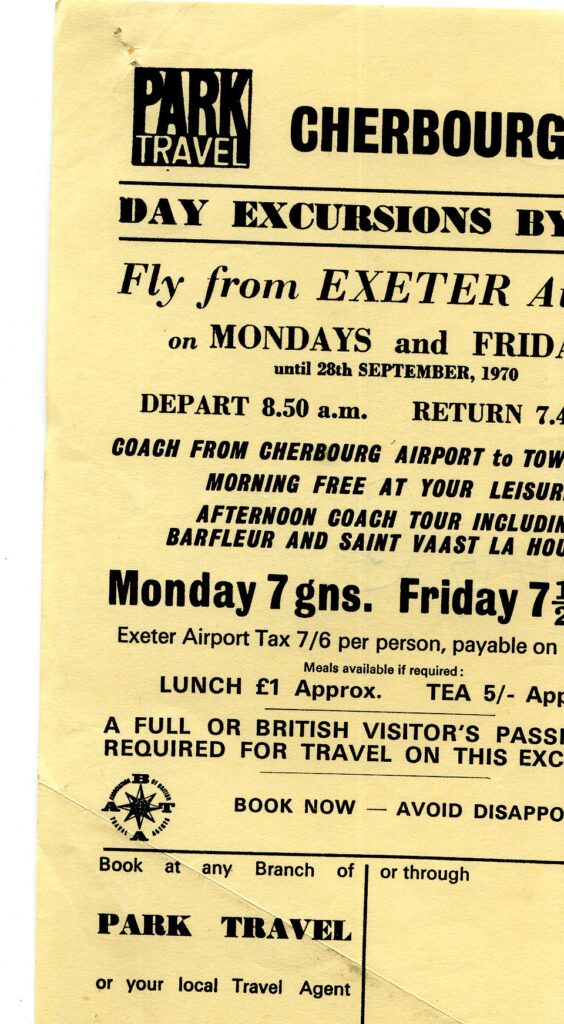
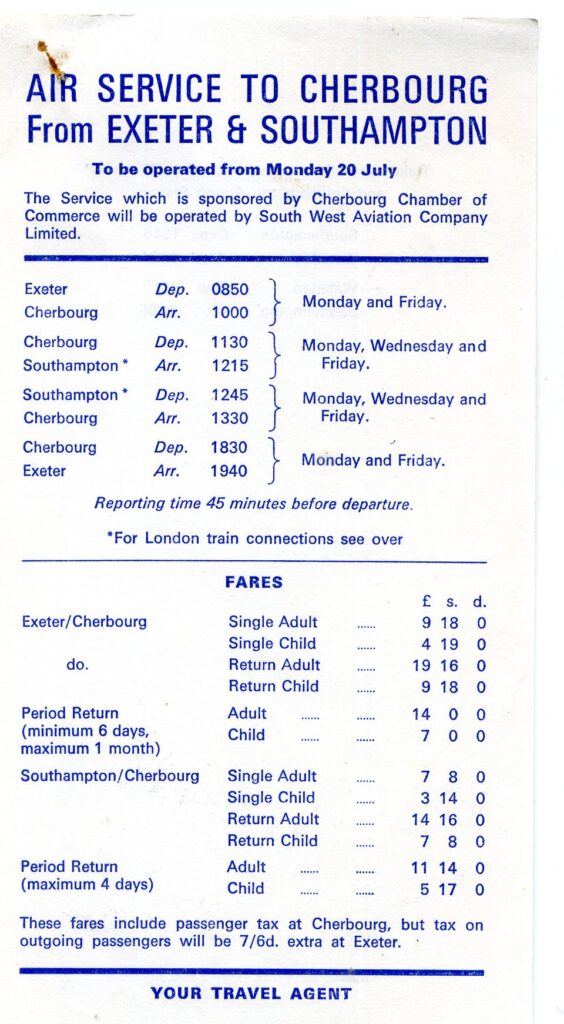
The summer of 1970 proved even more lucrative for SWA when the nationwide dock strike generated traffic carrying fruit and flower perishables from the Channel Islands and Northern France to the UK. On July 17th, G-APBC flew a dock strike-related service between Belfast Aldergrove and Southend. Following resolution of the strike, charter work continued to bolster business with Ford car parts charters between Birmingham and Cologne in October 1970 and the perishables routes continuing to develop early in 1971. On 17th January ’71, G-APBC made the first flowers and fruit flight from Jersey to Bournemouth. This service was repeated by ‘BC on January 31st and, by the end of the following month, SWA were flying up to five services per week. The potential custom on this route was huge and, on some days during the year, two Dakotas might make two return trips each. However, the route was not without competition and the Channel Islands had its own ambitious Dakota operator, Intra Airways. Additionally, Invicta Airways was offering its own larger capacity DC-4 and, soon, Saggitair would be looking for business for its Argosy fleet.
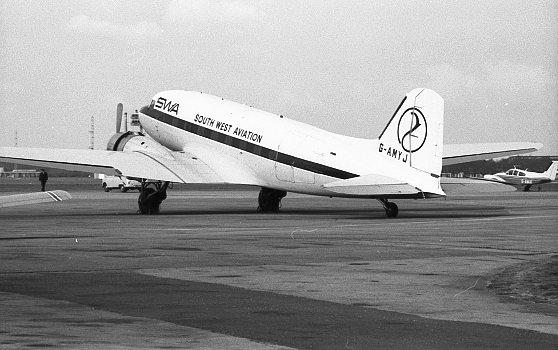
Three Dakota operators demonstrated their ability to work together for a passenger charter in January 1971. Dinard-based Rousseau Aviation had 100 passengers booked for their Dinard to Gatwick service on January 14th and needed extra capacity to supplement their own F-BAXR. South West Aviation provided G-APBC and Intra offered G-AMPY: the three Dakotas took off from Dinard and flew in a ‘loose vic’ formation to Gatwick. After standing-by for the day, the three took off in swift succession en route home to Brittany. Rousseau had operated quite a number of C-47s during the 1960s and was looking for that mythical creature, a DC-3 replacement. They followed the same route as Dan Air and purchased HS748s and Nord 262s. South West Aviation were also considering turboprop equipment and Fokker loaned them an F-27 on the same sales tour that visited Air Anglia. The Friendship was fully tested during April 1971 on routes to the Channel Islands, Brittany and Northern Ireland from the airline’s Exeter base. Meanwhile, SWA’s other turboprop, Skyvan G-AWCS, was proving useful in a 14-seat passenger mode on weekday flights between Plymouth and Heathrow. This service mirrored Westpoint’s earlier route and suffered the same problem with unreliable load factors. At the weekends, the Skyvan demonstrated its versatility by carrying Devon parachutists aloft.

G-APBC continued with passenger charters where a larger capacity was required than that offered by the Skyvan. Oil industry-related charters included a Newcastle-Sumburgh-Kristiansund on May 21st . ‘BC was back in Newcastle on June 11th for a Newcastle to Manchester to Bristol/ Cardiff service on behalf of Dan Air. The return leg to Newcastle was via Liverpool. Still in the North East, G-APBC flew a Newcastle to Sumburgh to Alesund charter on August 27th. G-AMYJ was also frequenting Shetland, flying Aberdeen to Sumburgh passenger transfers on behalf of Air Anglia during late June. This was halted abruptly on July 2nd when ‘YJ suffered a technical problem and had to turn back for an emergency landing at Sumburgh. She remained there until Scottish Aviation personnel mustered a team to provide remedial treatment which would allow the Dakota to fly to Prestwick. G-APBC, meanwhile. continued working hard, taking advantage of her freight/ passenger modes. Ford personnel were carried from Swansea to Liverpool and back on July 30th 1971 before switching to her freight mode to transport three tons of shellfish from Southend to Brest. Ford also provided further business with a Cardiff to Cologne return charter on October 25th following-on from a passenger charter between Gatwick and Rheims on October 23rd. Another operation for Ford was flown from Cardiff to Cologne on November 25th. Upon departure from the German airport, G-APBC headed south on a tramping charter flight which followed a circuitous route delivering ships spares to Gibraltar and encompassed stops at Nice, Naples, Algiers and Oporto before returning to Exeter on November 8th (7). The following day was memorable for South West in that it saw the re-signing of the Jersey perishables contract with five of the Island’s main horticulturalists. This would potentially offer shipments of 30 tons per week although, during the winter months, shipments of flowers and fruit would be much lower. This, coupled with poor load factors on the Heathrow route, caused cash flow problems during the 1971-72 winter. The air taxi division was closed down but this was insufficient to balance the books and the Company went into voluntary liquidation in February 1972. The liquidators kept the two Dakotas operating from Exeter and Hurn on the Jersey flower flights and ad hoc charter flights were operated for oil industry clients. In May 1972, a new group of investors bought the Company. They had plans to upgrade the fleet to Viscounts but, in the interim, G-APBC was doing much of the work with an oil charter on May 23rd, a freight run between Southend and Le Havre on 24th and a passenger charter between Newquay and Coventry on 31st. Ford were back as a customer on June 8th with a charter from Birmingham to Cologne. While the Viscounts never materialised, G-APBC continued flying regularly between the Channel Islands and Bournemouth Hurm during the Summer of 1972 with loads of fruit, vegetables and flowers. G-AMYJ was sold to SWA rivals, Intra, in August 1972 but G-APBC continued to operate on into the autumn. She was sold to long-time Dakota operators Air Freight Ltd and delivered to their Lympne base on October 23rd. She was noted at the Kent airfield on 12th November, still wearing her SWA colours but the days of South West Aviation were over.
(7) This round-the-houses charter is attributed to G-APBC in Propliner edition 111. Some earlier references cite G-AMYJ as the peripatetic Dakota.
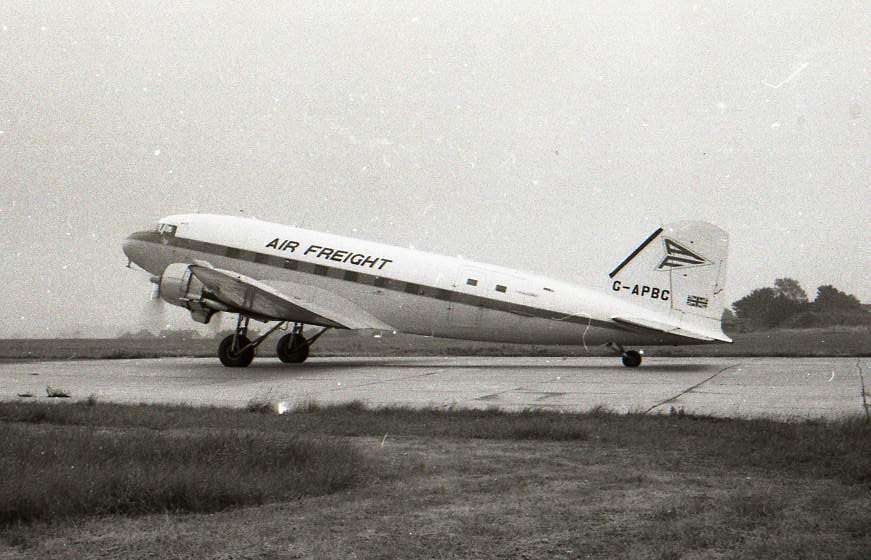
Air Freight had evolved from Skyways Coach Air and the established route between Lympne and Beauvais in France remained the same. Air Freight had added a second all-cargo route between their Kent base and Antwerp in Belgium. When Skyways had gone into liquidation in January 1971, the three C-47s operated by Air Freight were repainted appropriately and continued flying as a separate entity. In addition to the bedrock road/ air cargo schedules between major British cities and the Continent, the Company also operated in markets similar to the defunct South West Aviation. Oil industry charters and Ford motor parts contracts were both important although, during the early seventies, passenger charters were not operated. G-APBC was repainted during a Skyways Engineering overhaul at Lympne and the undercarriage doors were removed. By May and June 1973 she had appeared on the Antwerp and Beauvais routes in Air Freight titles and, apart from the occasional charter, this remained G-APBC’s regular work. The aircraft were loaded during the night and the freight schedules to the Continent departed each morning. Extra services would be run during the afternoon if justified by extra freight volume. G-APBC was also seen occasionally at other UK airports: Manchester and Glasgow on February 15th 1974. The promise of more motor parts business from Ford was initially addressed by the road/ air freight model but, subsequently, during 1974 Air Freight decided to base a Dakota at Southend to serve Ford’s German destinations. The airline also had to move its base in Autumn 1974 following the closure of the airfield at Lympne. The move to a new base at Lydd Ferryfield also prompted a reorganisation of the Company. Dan Air had now dropped the ‘Skyways’ title from its HS748 operations and Air freight evolved into Skyways Cargo Airline. A fifth Dakota was acquired in the form of BIA/ Macedonian/ Humber Airways G-AMSV in May 1975 with the intention of expanding into the burgeoning requirement for transport in the North Sea oil industry.
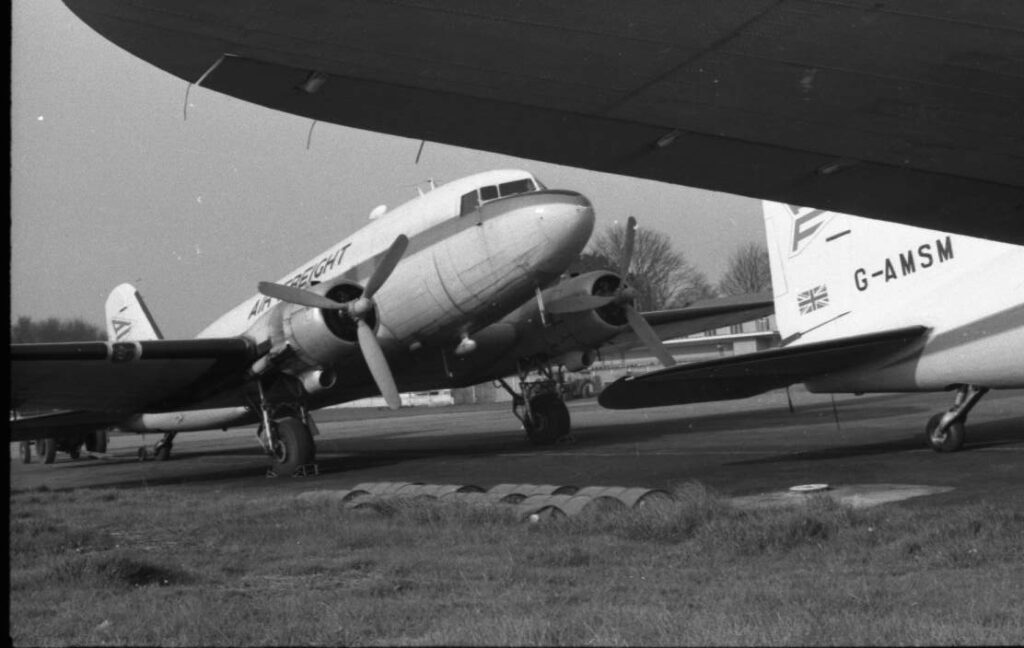
From July 1975, Skyways also based a Dakota at Dyce to cover the many oil company service contracts. These were often flown in conjunction with other operators and, depending on the aircraft, a passenger capability could also be offered. Other freight contracts were awarded to the Company including a nightly freight flight between Gatwick and Amsterdam on behalf of KLM and a 3-month operation flying freight between Heathrow and Brussels for Sabena. Air Anglia’s Dakotas G-AOBN and G-AGJV were added to the fleet as the Norwich-based airline transitioned to turboprop F-27s. Skyways were, themselves, considering buying F-27s or F227s but, for the time being, they had become the largest C-47 operator in Europe.
1976 saw the Aberdeen hub expand with passenger charters operated for Mobil and mixed freight on a spot charter basis. G-APBC was a mixed mode aircraft and wasn’t as thoroughly-equipped with cargo-handling features as G-AGYZ or G-AMWW. She was, however, used extensively on the cargo routes from Lydd and also on an expanding number of ad hoc charters around Europe.
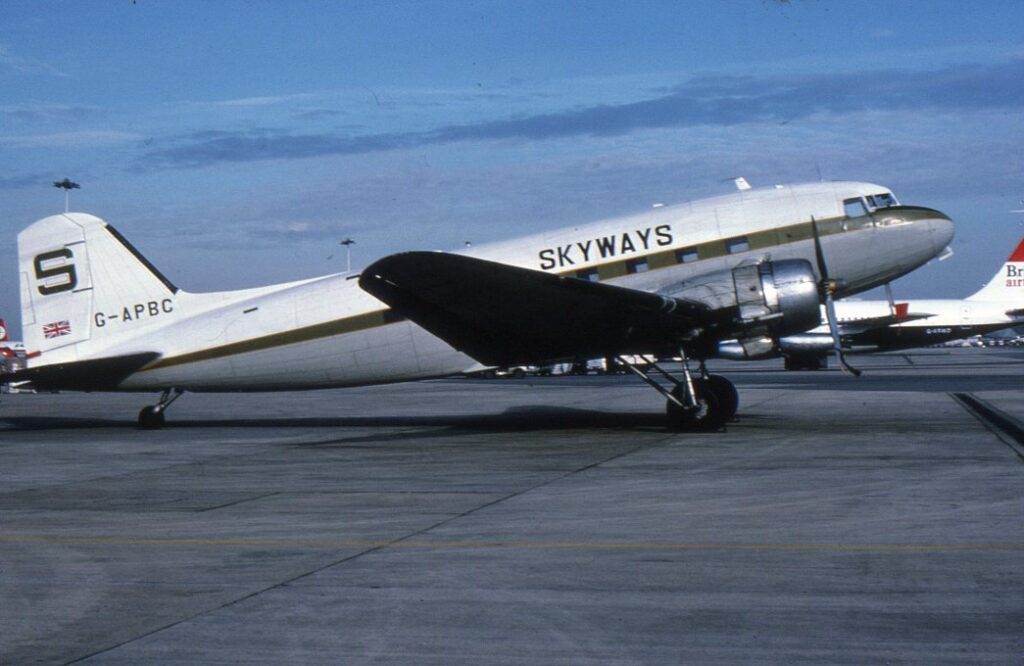
The oil companies started pushing for more modern turboprop equipment but, with companies like Kestrel, South West, Air Ulster and Saggitair going out of business, only BAF and Air Anglia seemed to be making the transition successfully. The Skyways C-47 fleet was reduced with the sale of G-AGYZ and G-AOBN in Ethiopia in summer 1977 and the writing-off of G-AMSM following a take-off accident in August 1978. Skyways, after evaluating the used turboprop market, opted for a pair of Fairchild F-227s from Wien Alaska. These US-built versions of the Fokker F-27 were the first of the type to be operated in the UK and this created some certification issues. Nevertheless with new large cargo doors fitted, they offered excellent freight capacity. Seating and a galley in each aircraft also made passenger charter work an attractive option. Delivered to Lydd as G-ASKA and G-ASKB at the start of 1979, they joined G-APBC on the regular freight runs to Beauvais, Antwerp and also Rotterdam. G-AMWW and G-AMSV had headed north to Aberdeen to cover the oil-related charters including a weekly return flight between Dyce and Brawdy in Wales – presumably to support rig operations. G-AGJV was being overhauled at Lydd, so it was up to G-APBC to support the F-227s on the regular cargo schedules and the nightly Gatwick to Amsterdam flight. By late spring, the contract with Mobil for flights between Aberdeen and Sumburgh had finished and the two C-47s returned to Lydd.
Royal Mail contracts assisted many independent airlines in the late seventies and Skyways were kept busy with mail flights from Lydd and Gatwick to East Midlands and Liverpool. Additionally, the Ford motor parts flights and newspaper deliveries helped to bolster the regular freight schedules across the English Channel. British Midland also contracted Skyways to operate some cargo services to Amsterdam but work wasn’t plentiful and G-AGJV was sold to Air BVI. She departed Lydd mid-February 1979 on a 6-day ferry flight to the Virgin Islands. G-AMSV was leased to Bretagne Air Services at Dinard in May 1980 and, with G-AMWW on overhaul, the two F227s and G-APBC were left to run the show. G-APBC operated the BMA freight schedule between East Midlands and Amsterdam on May 22nd and 23rd – for the ex-Derby Aviation Dakota it must have seemed like old times. Earlier in the month ‘BC had flown a Lydd to Frankfurt charter and the regular scheduled routes ran as normal. Business, however, wasn’t good and, despite claims that the airline was going to revive its Coach-Air services, finances were restricted during the economic recession.
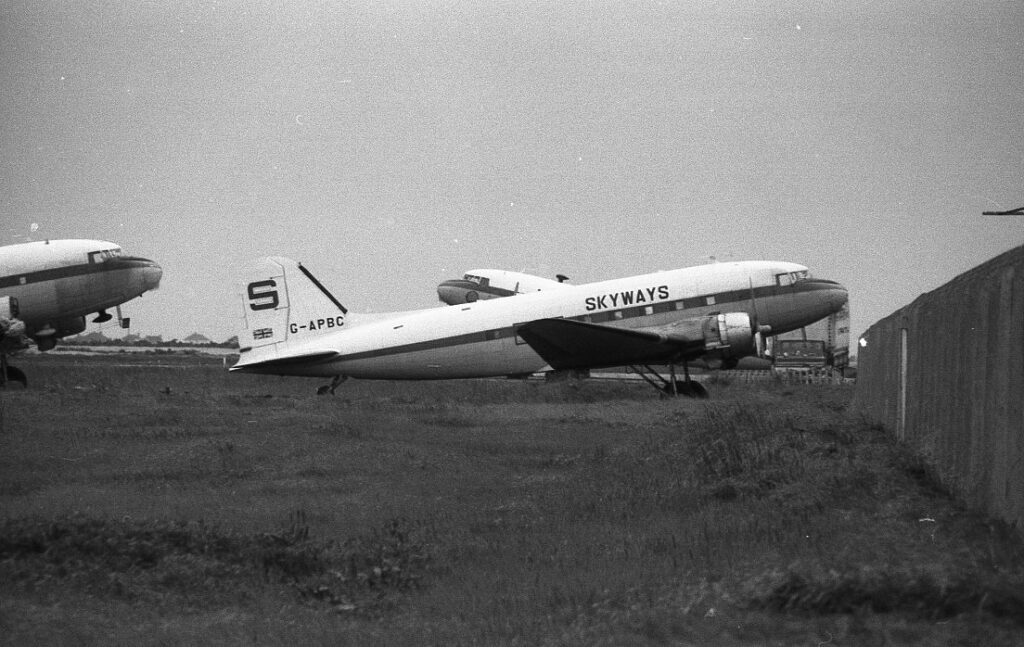
June 19th 1980 saw G-AMWW back in action after maintenance and she promptly departed to Aberdeen ready to fly cargo to North Africa via Lydd and Marseille. Upon completing this, she joined G-APBC on the Skyways and British Midland freight services. G-APBC was assigned a Lydd to Porto charter on September 23rd and, ten days later, she flew one of the Company’s last charters carrying livestock from Lydd to Nuremburg. The end of the line came on October 15th when the last Royal Mail flight was operated and the F227s were flown to Southend to be repossessed by financiers. After fifty distinguished years, the Skyways name disappeared from the skies of Europe. The two remaining Dakotas were parked-up at Lydd on October 16th 1980; they were eventually sold to Pan Universal Aircraft Services (CI) Ltd, a Jersey-based broker with a history of selling light airliners such as the DH Heron.
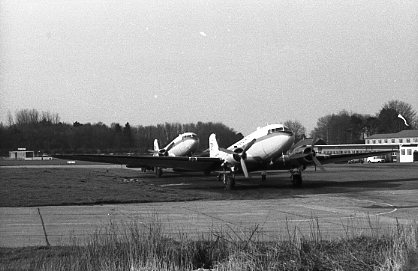
Both the remaining Skyways C-47s were sold in the USA with G-APBC arriving with her new owners on 1st September 1981 and being canceled from the British register on 23rd of the month. G-AMWW also traveled to the USA wearing her British registration and the Skyways ‘S’ on the tail. She was canceled from the UK register on 2nd November 1981 but was probably delivered some weeks earlier on 14th October. The sequence of ownership upon arrival in the States is reported differently: some sources suggest that G-APBC was bought by a corporation, donated to the Moody Bible Institute and sold-on to Missionary Flights International (MFI) while others (8) propose that both Dakotas were sold to MFI. Either way, G-APBC was registered to Missionary Flights and Services Inc. of West Palm Beach, Florida, and acquired the US registration N26932. G-AMWW also stayed in Florida and was registered N2685W in December 1981 (9).
(8) DC-1/ DC-2/ DC-3: The First Seventy Years. Jennifer Gradidge, Air Britain.
(9) ‘WW was being operated by B.Airways by June 1983 and remained with them for some years. Converted by Basler to a turboprop BT-67 in 2004, she continues in service with the Royal Thai Air Force.
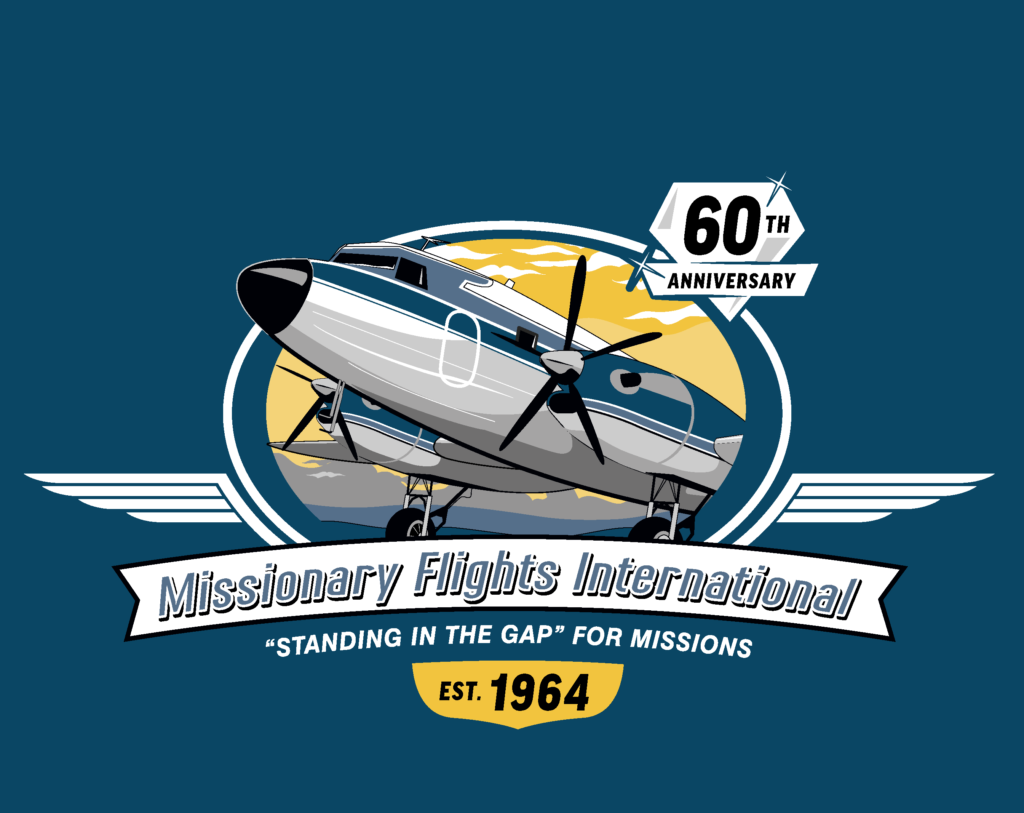
Missionary Flights International had been set-up by the Revd. Don Beldin in 1964 and was incorporated in the State of Florida. Early equipment included a Piper Tri Pacer and the unusual Riley Twin Navion N105N which was owned by Don Beldin between 1964 start of operations and 1996. Although aspiring to DC-3 operation, the organisation took some years to get there and early expansion came with a couple of Beech D18s and a C-45 between the late sixties and late seventies. This included the first aircraft to carry the N300MF registration, a Beech 18 which served from 1967 to 1979. The first aircraft to carry the letters N200MF was also MFI’s first C-47 and it arrived on 23rd February 1977. It slotted readily into the regular departures from West Palm Beach to destinations in Haiti, the Dominican Republic and outlying Bahamian Islands. MFI provided both passenger and freight transport for missionary groups operating in the Islands and operated the C-47 in a combi mode. Their motto, ‘Standing in the Gap’, reflected their ambition to help disadvantaged communities in the Caribbean which might otherwise miss-out on aid. When G-APBC arrived in 1981, she was well-suited to the 24 passenger/ freight configuration. Her original N26932 registration was changed to N300MF and she was painted in a new sea green colour scheme. Outbound flights from West Palm Beach optimised the payload by not carrying a full fuel load. On each outbound flight, normally on Tuesdays and Thursdays, the C-47s touched-down in the Bahamas to top-up on fuel. The flights generally departed Florida at dawn with one aircraft carrying passengers and one carrying freight. A third C-47, N2400, joined the fleet in May 1984 and was duly registered N400MF. Interestingly, she had been parked-up with the Stoltzfus organisation in Coatesville, Pennsylvania, for several years having been a spray aircraft (10).
(10) Stoltzfus had bought five aircraft at a military surplus sale in Arizona and N2400 and N2401 were both ex-US Navy R4D-6s which had previously been leased by the military to North Central Airlines. The civilian operator had re-engined the aircraft with Wright R1820 engines. Stoltzfus has assisted many Christian organisations over the years and the family are connected with Dynamic Aviation and the D-Day Squadron C-47 ‘Miss Virginia’.
Each of the MFI C-47s operated around 700 hours per year and regular maintenance could be handled by the organisation’s own engineers. In March 1996, the second Wright-engined R4D-6, N2401, arrived from Stoltzfus which meant that MFI had two Wright-engined C-47s and two Pratt & Whitney engined models. Also in 1996, N300MF was repainted in a smart two-tone blue and white colour scheme which has stayed with her ever since. The regular flights to Port-au-Prince, Cap Haitien, Pignon, Barahona and Santiago continued mostly without problems. In 1998, MFI did suffer a setback when N200MF experienced a loss of power on both engines following departure from Moss Town/ Exuma International Airport in the Bahamas on February 23rd. A successful forced landing was made around midday, approximately a mile from the airport and there were no injuries amongst the 24 passengers or the crew. The aircraft, however, was written-off. A ‘new’ N200MF arrived in December 1998 in the form of ex-Wycliffe Bible Translators/ JAARS C-47 N13JA. The Dakota had served its previous owners for some 35 years, most recently in Kenya and her arrival meant that R4D-6 N2401 could be withdrawn from use (11). The new arrival was briefly registered N301MF and painted in MFI’s 2-tone cheat line scheme – although in orange and brown tones. Another Pratt & Whitney-engined aircraft, the C-47 was re-registered N200MF on May 2nd 2000.
(11) Some sources give a later date for the retirement of N2401. While withdrawn from use at West Palm Beach, the aircraft was storm damaged in 2003 and broken-up for spares.
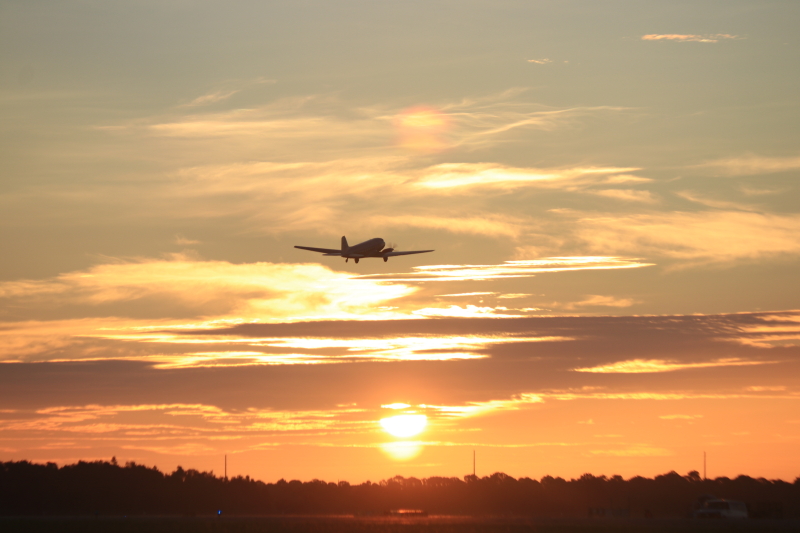
The start of the new Millennium saw Missionary Flights developing new plans to upgrade to turboprop equipment. They had a different replacement option to South West Aviation and Skyways: MFI planned to replace their piston-engined C-47s with turboprop-powered versions of the C-47. The first to arrive was to become another N200MF – this new addition was s/n 9766, an ex-RAF (FD933) and South African Air Force (6879) aircraft which had been converted by Dodson to turbo power for the SAAF. The aircraft was delivered by Dodson on September 8th 1999 and became N200MF on 4th April 2003. The previous N200MF, s/n 4082, had been returned to Dodson on 25th February 2003 with the registration changed to N200MX. The new arrival started flying alongside N300MF and N400MF on the Caribbean services and it was soon clear that the turboprop no longer required a fuel stop at Exuma en route to Haiti. The Jet A-1 fuel was also easier to obtain and, indeed, could be purchased very cheaply in the Dominican Republic at Barahona.
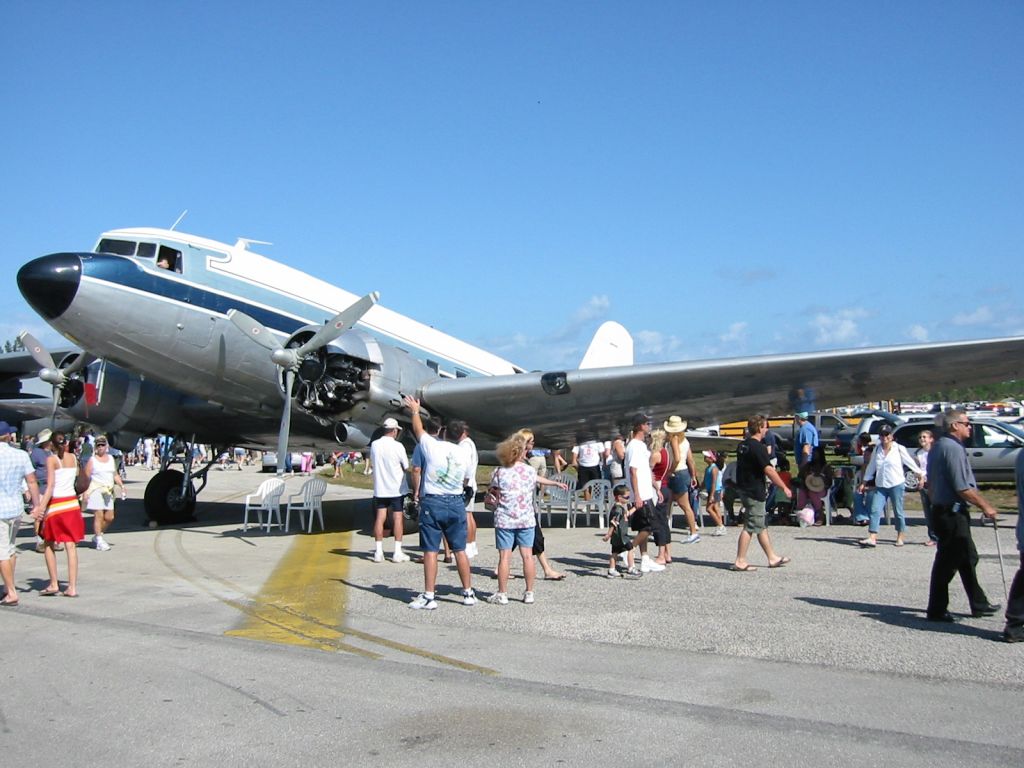
MFI saw another development when they moved from their fairly basic facilities at West Palm Beach to purpose-built hangar and office facilities at Fort Pierce Airport in 2006. The two radial-engined C-47s continued reliably but, in 2009, N300MF was in serious need of a repaint to repel the salty Atlantic atmosphere. She also had a longer than anticipated stay in Nassau during the summer of 2009 owing to engine problems. The old Pratt and Whitneys were becoming demanding but were, at least, serviceable by in-house engineers – indeed, MFI had impressive engineering credentials which also extended to their pilots who are fully-licensed engineers. While the turboprops were reliable and required little minor servicing, the major overhauls at 6000 hour intervals could not be carried-out by MFI and were hugely expensive. A change of two engines carries a $500,000 price ticket and is needed every eight to nine years.
The Haitian earthquake on 12th January 2010 led to a big demand for the C-47s and an MFI aircraft was one of the first to arrive in Port-au-Prince with relief supplies after the disaster. The next aircraft to join the fleet was another turboprop – in this case a Schafer Aircraft modification which had operated in both Africa and the USA. Service with the US Forestry Service in California had yielded the registration N376AS before she was delivered to MFI on April 29th 2010. Following 18 months of maintenance and overhaul, the aircraft entered service as N500MF in autumn 2011.
The arrival of N500MF prompted the departure of the radial-engined aircraft with N300MF sold to Florida Air Cargo in 2012 and N400MF passing to Kingdom Air Corps on April 8th 2015. A stop-gap Aero-Modifications 65TP was loaned to MFI by the Stoltzfus organisation in 2012 and operated with MFI as N467KS for a year before returning to Kidron, Ohio, in 2013 (12). N467KS was also an ex-SAAF turboprop conversion rather than one of the more widespread Basler conversions. MFI also aimed to add a further 65TP Dodson conversion and, in 2015, acquired an aircraft which had been parked at Lanseria, near Johannesburg for nigh on 12 years. The all-white 65TP had most recently been registered as 5Y-RDS and had worked on aid projects in Kenya (13). Owing to the long hibernation, replacement engines, propellers and avionics had to be sourced prior to the ferry flight to Florida. Eventually, pilots Ray Oostdyk, Ian Hengst and Kevin Stratton made the 6-day transatlantic crossing in May 2017 via stops in Cape Verde and Fortaleza, Brazil. Scheduled to become yet another ‘N300MF’ following a long term $6.1 million upgrade, the project was eventually cancelled in November 2022 and the bare hull advertised for sale at a knock-down price the following August. The gap in the fleet is likely to be replaced by a new ‘N300F’, also a DC-3 65TP, which will have been rebuilt by Preferred Airparts at Kidron, Ohio.
Meanwhile, the original N300MF, ex-G-APBC, was sold to Sergio Alen of Alen Enterprises, Opa Locka, Florida on June 25th 2012 and re-registered N271SE.
(12) N467KS went on to fly for Samaritan’s Purse and was, unfortunately, involved in a fatal accident some years later when it crashed at Kidron while being flown by Brian Stoltzfus.
(13) The airframe which went on to become 5Y-RDS with the Red Cross was, in fact, the first turboprop ‘Cargomaster’ developed by AMI/ Schafer Industries.
Sources: Propliner #87 article by Martin A.Cooper, Summer 2001. Aviation News, July 2023, edited by Geoff Jones. Treasure Coast Palm, May 2017, Propliner Info Exchange.
Thanks to Larry Campbell, Vice President of Operations, MFI.
Sergio Alen had worked in the Florida aviation for many years. Working as a licensed engineer with Caribbean Aircraft Development Industries, Eastern Airlines, M&M Aircraft Services and the Miami Aviation Corporation in the late 1970s, his experience included conversion work on Prinair’s Heron fleet and upgrade and inspection work on 707s. He obtained a flying license in 1987 and became a flight engineer on Regal Cargo freighters in 1992. The following year he and Rodolfo Campo formed Alca Avionics which he ran in parallel to various positions as maintenance supervisor with airlines in Florida. During the late 1990s, Florida Air Cargo operated Beech 18 N122V under lease from South Florida Aircraft Leasing Ltd and also tri-gear Beech N967. In 1996, they added N15MA as their first C-47, also on lease from South Florida Aircraft. Sergio Alen became Director of Maintenance for the Company and, when the three existing owners decided to close the business in 2012, Sergio bought the Company and took over the lease on a Cessna Caravan. The new management operated the Caravan for around 60 hours per month but decided that they needed the extra capacity of a C-47. The Company bought N300MF from Missionary Flights Inc and, on June 25th 2012, registered her to Alen Enterprises as N271SE. N15MA had departed in 2009 but was brought back into the Company fold in 2013, followed by N138FS which had been languishing in Puerto Rico and needed a year’s renovation.
The three-Dakota operation, supplemented by the Cessna Caravan, settled into regular operations from Opa-Locka Airport and, as a Part 135 Certificate company, could operate throughout the USA, Caribbean, South and Central America. Their primary zone of operations was, however, within a three-hour flying time radius circle centred on Opa Locka. While this corresponds to around 400 nautical miles, most operations are, in practice, between Florida and Nassau, the Gateway to the Bahamas, which is around an hour’s flying time from their South Florida base. The airline offers on-demand cargo charter facilities and, rather than arranging its own freight booking and consolidation, prefers to work with freight forwarders who make whole-aircraft bookings. This generally results in between one and three departures to the Bahamas each day with the first flight taking to the skies around 08:00 to 08:30, heading out across Miami North Beach en route to Lyndon Pindling International Airport. Payloads are generally 6700- 6800 lbs but up to 7500 lbs can be accommodated at the expense of a full fuel load. The team at the airline remains quite small with around a dozen involved in flying, maintaining and loading the aircraft in Florida. The Bahamas tourist and hotel industries provide much of the business for the Company with perishable goods and foods flown in each day. At the back-end of the year, consumer goods and gift deliveries also guarantee full payloads as Christmas approaches. The Covid epidemic led to a serious slump in the Bahamas tourist industry but the airline was in demand for medical and emergency cargo deliveries.

The engineering abilities of the airline’s staff ensure that the fleet remains operational: Sergio Alen has a strong engineering background, Keith Kearns, the Director of Operations, is both a licensed pilot and an A&P qualified mechanic who has worked with the Company since 2003, Danny Cruz is the airframe and aero engine mechanic. The Company says that, on any given day, maintenance work is likely to be ongoing for at least one of the three C-47s on the Opa Locka ramp. The Company follows the same maintenance programme as MFI with 50 hour airframe inspections and engine overhaul every 100 hours. Over the years there have, fortunately, been few serious incidents with the fleet. N15MA hit a fence while landing at Nassau in February 1999 but, despite serious damage, there were no major injuries and the C-47 proved repairable. More recently, N271SE suffered the collapse of her port undercarriage leg while parked at Nassau in December 2023. Ten days after the incident, a revival team was despatched from Florida on December 23rd. Sergio Alen, Keith Kearns and Danny Cruz transported spares and airbags to Nassau and, with the help of a local mechanic, lifted the C-47 that same afternoon. Following a wing tip repair and propeller blade change, N271SE will be returning to Opa Locka and operations from Florida.
The Florida Air Cargo trio of aircraft is the biggest fleet of working C-47s in North America. Indeed, Sergio Alen’s ambitions include the addition of a fourth C-47 – his logic is that the cost of a single turboprop DC-3 such as a Basler BT-67 would equate to the current value of three or four radial-engined Dakotas but only offer 25% of the capacity. Hopefully N271SE will continue to have a long and safe career in the sunny skies of Southern Florida.
Sources include:
Vintage Aviation News, 2nd March 2023, ‘Florida Air Cargo – where Douglas DC-3s still work for a living’ by Moreno Aguiari and Richard Allnutt.
www.proplinerinfoexchange.com Article by Ralph Pettersen, Aug 2022.
Florida Air Cargo website.
Hits: 115
